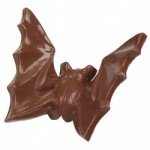The size of chocolates
The size of chocolates

In this activity students assume that all of our pieces of chocolate are about the same thickness and proceed to approximate their volumes by comparing only their surface areas. Consider showing students our pictures of the chocolates either on paper or through a screen from our site.
Ask students to consider how they might determine which piece of chocolate contains the largest amount of candy. Give students a few minutes to think about the problem and then have them pair up and discuss strategies with a partner. Facilitate a whole-class discussion on how they could get a good estimation of the volume for each chocolate. Hopefully a student will offer (or you may need to lead the conversation to) finding the area by laying a grid over the chocolates. By counting whole and partial squares students are working with the concept of surface areas and thinking about area as a measure of covering. You can use our chocolate-grid sheet, which has a grid laid over the chocolates. Another possible way to find the surface area of the chocolates is to use the mean radius method. See our solutions document for more on this. You might have students use both the mean radius method and the counting squares method. It will be interesting to see how close their areas are for each chocolate.
No matter which solution method students use, consider having students report their thinking through a doc camera. Focus on student's mathematical ideas and problem solving strategies. The concept of area as a measure of covering should be the theme of the sharing and class discussion. You may also consider using actual chocolates of different shapes and sizes as a class activity my colleagues did in their classrooms.

